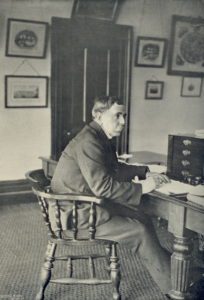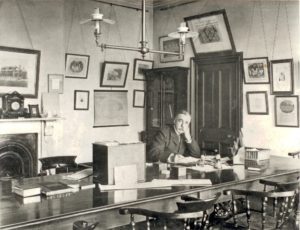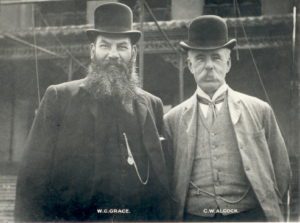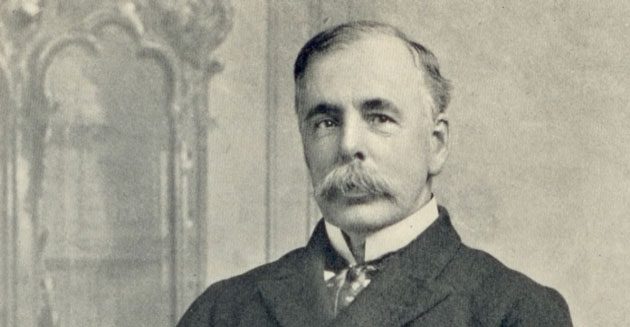The following is a feature on the impact of Charles Alcock on British sport, Surrey County Cricket Club and The Oval from an edition of The Nightwatchman, originally written by Simon Wilde.
The final Test match of the English season holds a special place in the heart. Maybe it’s the bittersweetness of the moment: the chance to savour the last drop of cricket’s summer wine and reflect on what the previous months delivered; the triumphs and disappointments, the dreams fulfilled and dreams dashed.
The frippery of a few white-ball internationals in September can’t compare with this protracted parting from the purest form of the game. Not many sports do nostalgia better than cricket and no occasion does nostalgia better than the last Test of the summer. At its best, it’s an open-air version of Last Night of the Proms.

Ideally, the last Test forms the climax to a thrilling series: the fate of the Ashes hanging in the balance, or the Wisden Trophy, or the D’Oliveira or the Pataudi; a cup-final atmosphere and not a spare seat in the house.
Many of English cricket’s most luminous moments attach to such occasions. The drama of the last day of 2005 may set the standard in this respect – catastrophe flirted with, then joyously, madly averted – but there have been other instances, no less weighty in their day, of England claiming the spoils at such times.
The Australians being vanquished for the first time in 14 years in 1926 was one, when more than 100,000 people – the largest crowd to ever watch a Test in England – went through the turnstiles. Another came in 1953, when England won the Ashes for the first time since 1932–33, Denis Compton hitting the winning runs and Brian Johnston nearly losing it in front of the microphone as spectators swarmed onto the pitch, his voice wobbling with excitement as he shouted: “It’s the Ashes… the Ashes!”
Given the showdown nature of a final Test, the crowd is often more involved than at other points in the calendar: by helping mop up the sodden playing area, spectators literally played a walk-on part in Derek Underwood’s against-the-clock demolition of Australia in 1968, and in 2000, when England completed their first series win over West Indies in 31 years, the public was allowed onto the outfield to watch Nasser Hussain raise aloft the Wisden Trophy.
I was there, jostling among the throng, my six-year-old son Freddie on my shoulders, marvelling with the rest of them. The celebrations become essentially collaborative affairs, a conjoining of players and public, a process framed by the podium finish (now that security prohibits public invasions of the playing area): the on-field presentation of the trophy, the ticker-tape, the fireworks, the champagne-spraying, the players’ families joining the parade.
Other plotlines present themselves in these grand finales, individual stories within the larger pictures, futures that beckon, and pasts to be celebrated. With winter tours looming, places may still be up for grabs and some duly take the opportunity to grab them, as Basil D’Oliveira most famously illustrated. David Gower once sealed his place for a fifth tour of Australia with a sublime late-August century against India in 1990.
Then there are the retirements, the last glimpses of favoured champions: the three cheers, the guards of honour, and the flag-draped chairing-off by teammates. The last Tests of summer have bidden farewell to many of the game’s greats, including the greatest of them all, Don Bradman, who bowed out to a second-ball duck in 1948. The English nights were drawing in when Viv Richards took his leave, as they were when Curtly Ambrose did the same two West Indies visits later. Alec Stewart, a local boy, played the last of his 133 Tests at summer’s end and Andrew Flintoff signed off with an Ashes-clinching direct-hit run-out of Ricky Ponting.
Lucky is the ground that hosts such occasions. And of course the ground that has hosted all these occasions is the same one: The Oval.
***
Lucky is the ground… except you make your own luck and the man who made The Oval’s was Charles Alcock, secretary of Surrey for 35 years until his death in 1907. Alcock was one of the giants of Victorian sports administration, who played a leading part in the organisation of early football and rugby union internationals, as well as Test matches. The full extent of his pioneering work as administrator, official, player and journalist is chronicled in Keith Booth’s book The Father of Modern Sport: The Life and Times of Charles W Alcock (2002), but what is relevant here is that Alcock applied to cricket some of the innovations he had first brought to other sports.

Alcock, born in Sunderland and educated at Harrow, where house matches were played on a knockout basis, was also the moving force behind the creation of the FA Cup, first held in 1872 and won under his leadership by Wanderers FC. Through Alcock’s connections with The Oval, many of the early Cup finals were held there, as were England’s early home football and rugby international fixtures. It was not therefore such a big step for him to envision a cricketing contest between England and Australia towards the latter stages of Australia’s 1880 tour. This was particularly pertinent as MCC had refused to host the Australians – partly because of their questionable amateur credentials and partly because Lord Harris’s team had been treated to an ugly riot at the Sydney Cricket Ground in 1879. The commercial appeal of a such a project was obvious – the Australians had drawn big crowds to The Oval during their ground-breaking tour of 1878 and, at one of the games, swathes of people had over-run the turnstiles. The crowds had been much bigger than for any previous Cup final or football or rugby international.
Once Alcock had persuaded Lord Harris to support the scheme, and eventually take on the assembly and captaincy of the England team, nothing more stood in the way other than to induce Sussex, with the assistance of a cheque for £100 in compensation, to postpone by a week their own fixture against the Australians at Hove. What is now recognised as the first Test on English soil took place between 6 and 8 September 1880. More than 48,000 people paid for admission over the three days. Two years later, when the fixture was repeated, Australia’s sensational first Test victory on English soil stunned everyone including Alcock; one witness venturing into the Surrey offices described how Alcock “sat down on the huge iron safe and buried his head in his hands, seemingly oblivious to everything”. But the safe he sat on was going to be fuller in future because this thrilling contest, won by Australia by seven runs, confirmed that England v Australia was box-office. Around 20,000 attended both days of play, and several other appearances on the ground by the touring team (they also played Surrey, the Gentlemen, the Players, and Alfred Shaw’s XI) significantly boosted the club’s match receipts for the season from £2,260 in 1881 to £12,329.
The financial success of these early Test matches led to rapid expansion. The first three-match series in England took place in 1884, with Lord’s and Old Trafford also hosting games, and from 1899 Australian visits involved five matches, with Trent Bridge and Headingley added to the list of venues. This expansion, while welcome, posed a challenge to The Oval’s position – for the first time, the committees of the major counties vied for pieces of the financial pie. By 1902, when Sheffield and Birmingham staged their first Tests (at the expense of the 1899 newcomers Leeds and Nottingham), there were more venues than matches to go round. Yet The Oval was to hold onto a privileged position.
Why this happened was again down to the deft and tireless hand of Alcock. Significantly, he got involved in acting as the ground-agent for the now near-annual visits from touring teams to Britain’s shores. He had a part in organising Australia’s 1878 tour and was even more heavily involved in their scheduling for 1882: hence the five tour dates at The Oval, including the one Test match, even though Lord’s was now prepared to let Australia’s sharp-eyed businessmen-cricketers through the gates. From then until the creation of the Board of Control for Test Matches in England in 1898, a body that effectively handed control of the game back to Lord’s, Alcock was local organiser for several Australian sides and the Parsees, South Africans and Philadelphians among others. During this period, Alcock wielded great influence and it was largely in his gift to decide which venues played host when. Although the scheduling for Australia’s tours of 1888, 1890 and 1893 saw the second Test allocated to The Oval and the third to Manchester, by 1896 there was a reversion to the original pattern of the 1884 and 1886 tours, with The Oval staging the final Test.
As luck would have it, the final Test of 1896 proved to be a big match. The series stood at 1-1, so The Oval was effectively staging yet another cup final, just as it had staged every FA Cup bar one between 1872 and 1892. The occasion is remembered for an opportunistic threat of strike action by five of England’s professionals unless they were paid £20 rather than £10, but as a contest it lived up to its billing, around 48,000 paying spectators watching a low-scoring game handsomely won by England. No less importantly to The Oval’s future, 1896 also saw the renewal of the ground’s lease and Alcock and the committee swiftly committed to spending £10,000 (which turned out to be much more) on upgrading the pavilion and other parts of the ground. Alcock had put them onto a winner and they knew it.
***
The Oval was to stage the climax to every Test match summer between 1896 and 1972 with just two rather minor exceptions. In 1931, the ground was used for the second of three Tests against New Zealand, but the circumstances were not normal because the New Zealanders had originally only been invited for a one-off Test. Only after their strong showing at Lord’s were they offered two further fixtures, one at The Oval, the other at Old Trafford. The following year India were similarly invited for a one-off Test, and this was staged at Lord’s.

The sequence properly ended in 1973, a summer of split tours, when The Oval staged the first Test of the second series against West Indies, and similar arrangements in split summers deprived it of the final Test in 1978, 1982, and 2010. In 2012, for logistical reasons connected to London hosting the Olympic Games, it staged the first Test against South Africa and Lord’s the last. Other deviations from the normal pattern occurred in 1980 when The Oval staged the fourth of five Tests against West Indies, and in 1983 when the main cricketing event of the summer was the World Cup; that time The Oval hosted the first of four Tests against New Zealand. In 1998, The Oval did not host any of the five South Africa Tests because it was allocated a one-off Test against Sri Lanka instead, but this still took place in the last week of August and was a huge success, 70,000 people generating receipts of £1.4 million.
Although there is nothing in Surrey’s long-standing staging agreement (which ends in 2022) specifying that The Oval must stage the final match of the summer, it is unthinkable that it would not do so for an Australia tour. The agreement does specify that if there are two tours, as there usually are, the match has to be part of the bigger of the two. Hence, although this summer’s hundredth Test at The Oval is actually chronologically only the third of the seven in the season, that is because South Africa tour first and West Indies second. Starting on 27 July, it will be early for an Oval Test: only seven of the ground’s previous Tests have started before August, the earliest of them on 8 July for India’s visit in 1982. The Oval not only gets to stage the showpiece occasions, it is also tends to get the driest weather. For that, they have Alcock to thank.
The Nightwatchman is Wisden’s cricket quarterly. Surrey fans can get £2 off both print and digital versions of the Nightwatchman Oval special by entering the code SCCC17 at the checkout.










